The Shingleback Lizard, also known as Tiliqua rugosa, is a unique lizard species found in Australia and is particularly popular among reptile lovers due to its looks and gentle behavior. Considerations in this blog post will focus on various aspects of this exciting lizard, helping the readers to comprehend its biology, behavior patterns, and husbandry. We shall seek to understand the environment and the foods necessary for maintaining their health in captivity. Besides, the reader will also get enlightening information on their social behaviors and strategies to withstand environmental changes. This article will enable the readers to appreciate the factors that make the Shingleback Lizard the centerpiece of attention among reptile lovers, allowing potential caretakers to know what is necessary to guarantee the well-being of the reptiles.
What Makes the Shingleback Skink an Ideal Pet?
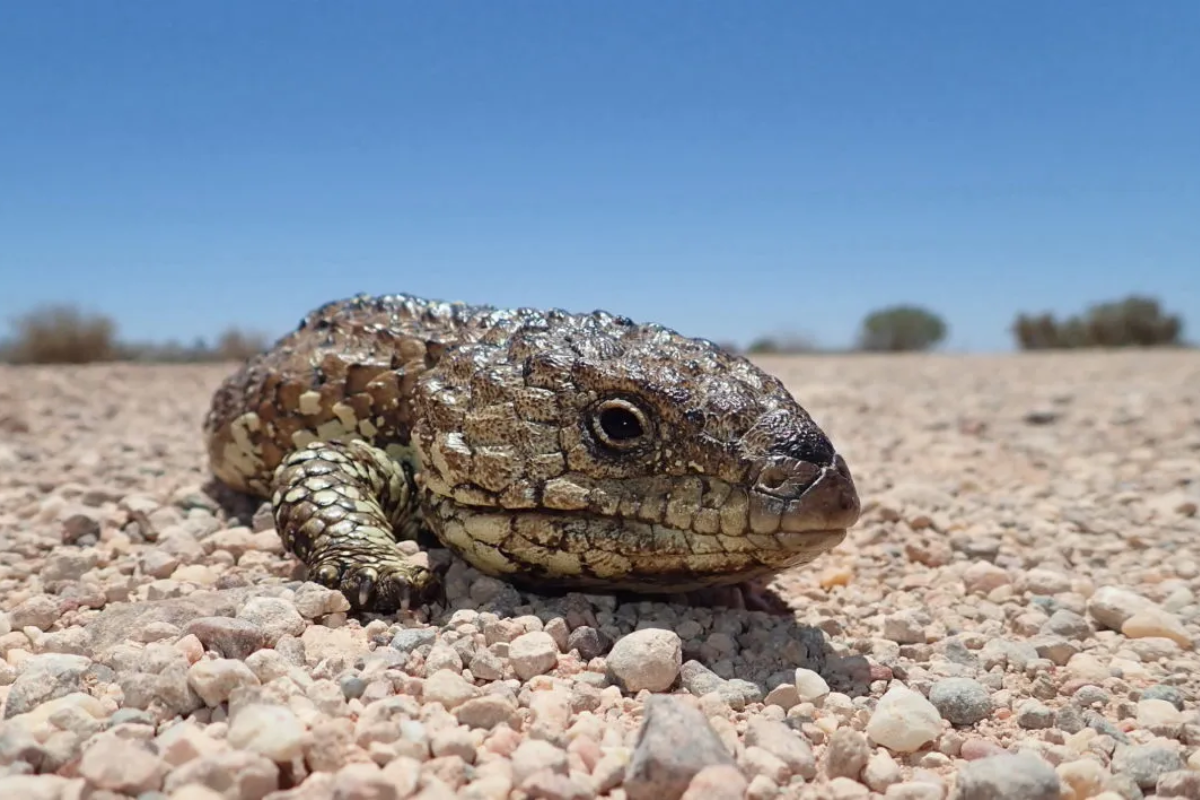
Shingleback skinks have features that cater to their popularity as pets. First, they can be maintained in various environments and do not require much effort compared to other reptiles, making them suitable for both beginner and veteran reptile keepers. Due to their natural calmness, the possible stress of dealing with the more aggressive species in some cases is reduced. Additionally, they are pretty small (the maximum is approximately 16 inches), making them easier to keep in several places as long as the enclosure is adequately set up with the appropriate temperature, basking area, and hiding spots. Regarding what skinks eat in captivity, their diet comprises most vegetables, fruits, and insects. Hence, managing their diet is easy, allowing them to consume all the necessary vitamins. Interestingly, both male and female Shinglebacks exhibit distinct social behavior in interactions with each other and can form monogamous couples. This fact brings a new interest in observing Shinglebacks as pets.
Shingle back’sShingleback’s Unique Behavior
Perhaps one of the most unique characteristics of the Shingleback Lizard is that it is monogamous, which is uncommon in other reptiles. Because they are skinks, they usually return to the same mating partner every breeding season. However, pair bonding does not restrict their social interaction since they are observed moving about in pairs. Their slow movements due to their well-protected body and short limbs are also characteristic of these species as they are not very agile. Shinglebacks increase their activity levels during the summer seasons, as in other ectothermic animals, where external heat sources are used to heat the organism’s body. They also display an interesting tongue-flicking behavior when threatened, their blue coloration engaging in this form of bluffing. Recognizing these behavioral patterns helps caregivers to mimic the natural condition of a Shingleback, thus making it healthy and stimulating for these reptiles.
Why Choose a Shingleback Skink Over Other Reptiles?
The Shingleback Skink stands out from other reptiles due to its unique combination of adaptive traits, ease of care, and captivating behaviors, making it an excellent choice for reptile enthusiasts. Firstly, their hardy nature allows them to thrive across diverse climatic conditions, enduring temperature fluctuations that might challenge other reptile species. This characteristic resilience simplifies maintenance, as Shinglebacks can adapt to various captive environments with appropriate habitat simulation, maintaining a temperature range between 75-85°F (24-29°C) with a basking spot reaching up to 95°F (35°C).
Furthermore, the Shingleback’s dietary requirements are easily manageable. They consist of a balanced mixture of vegetables, fruits, and occasional insects, ensuring nutritional adequacy with ease. Their relatively peaceful disposition contributes to stress-free handling, reducing risks of injury to both the keeper and the lizard.
In addition to its pragmatic benefits, the Shingleback Skink is known for its unique social behaviors, especially their monogamous tendencies, providing fascinating observational opportunities rarely seen in other reptiles. The combination of these traits enriches the captive experience and aligns well with the care abilities of novice and veteran reptile keepers, making the Shingleback Skink a distinguished choice over other more demanding reptilian counterparts.
Pros and Cons of Owning a Shingleback Lizard
Owning a Shingleback Lizard has been an enlightening experience for me due to several notable advantages and some considerations. On the plus side, Shinglebacks are incredibly hardy and require minimal maintenance compared to other reptiles. Their diet of vegetables, fruits, and insects is simple to manage and ensures they receive comprehensive nutrition without the complexity seen in more specialized species.
Their docile nature and tolerance for handling make them an ideal pet for both beginner and veteran reptile enthusiasts. Watching their unique social interactions, including their monogamous pair bonding, adds a layer of interest, enriching the overall experience of keeping them.
However, there are drawbacks to consider. Shinglebacks require specific environmental conditions, such as a habitat temperature maintained between 75-85°F (24-29°C) and a basking spot around 95°F (35°C), which can necessitate additional equipment and ongoing monitoring. Moreover, their slow movement may require more mental stimulation to stay active and healthy.
Balancing these pros and cons, owning a Shingleback Lizard can be a highly rewarding experience if you’re prepared to meet its environmental and dietary needs. It offers companionship and fascination, unlike any other pet.
How to Set Up a Perfect Habitat for Your Shingleback
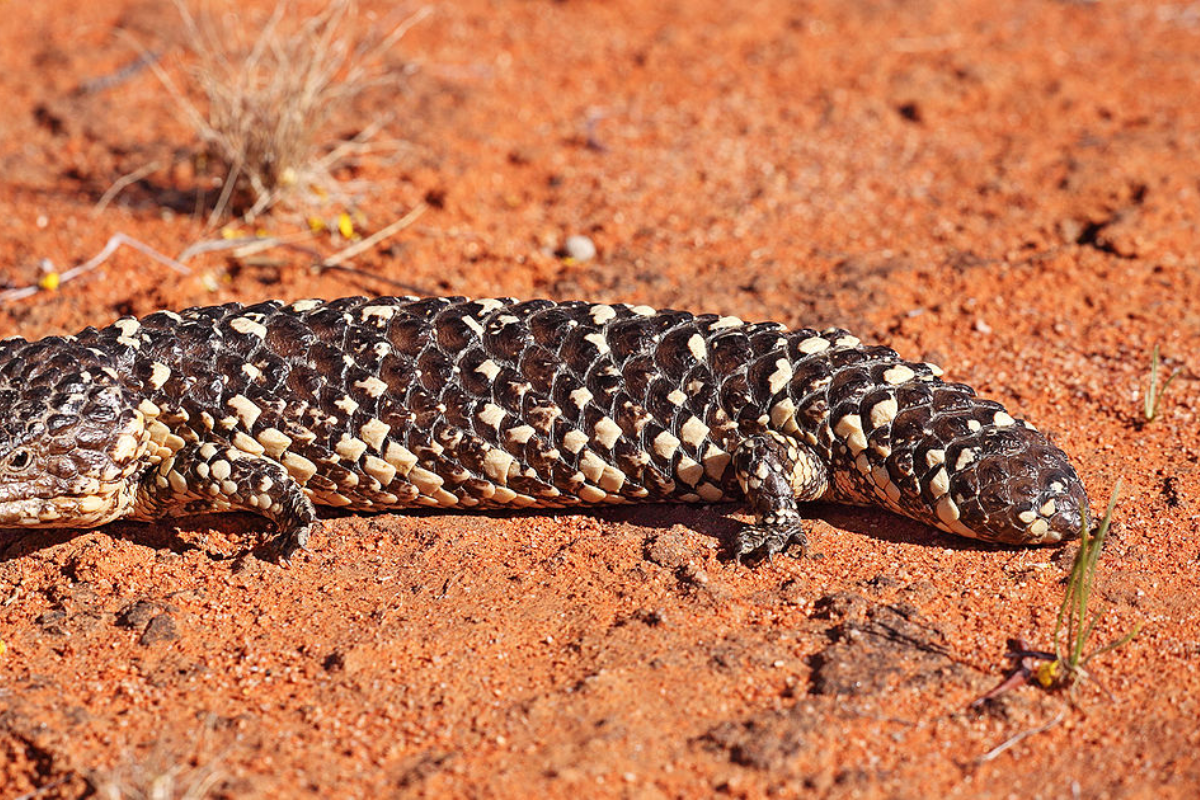
To properly create an optimal habitat for a Shingleback Skink, one needs to consider multiple environmental parameters in the terrarium, which are the same as those in the wild. The enclosures must be large enough, measuring at least 40 gallons, giving space for the lizard to explore. It is also essential to mention that the substrate is vital for their health, so mixing sand, soil, and the materials these lizards are usually found in nature is quite ideal. It is necessary to say that temperature control is a must here, so a range of 75-85°F must be maintained, including a basking area of 95°F. This can be done by using heat lamps and ceramic heaters in combination. The light that emits ultraviolet radiation (UVB) is also essential to allow calcium metabolism and to help avert metabolic bone illness. Incorporating hiding areas in the form of rocks and logs and a humidity level of 35% to 45% also aids in the overall environment. Cleaning up shores and contaminating the water source must be regulated to avoid sickness and foster the well-being of the lizard.
Essential Enclosure Requirements
To establish an enclosure that effectively caters to the needs of a Shingleback Skink, adherence to several key parameters is essential:
- Size: The enclosure should have a minimum capacity of 40 gallons to provide ample space for exploration and movement.
- Substrate: Use a well-draining mix of sand and soil to replicate the skink’s natural habitat and provide a comfortable base for burrowing activities.
- Temperature:
- General: Maintain an ambient temperature range of 75-85°F (24-29°C).
- Basking Spot: Ensure a specific zone reaches 95°F (35°C) using heat lamps or ceramic heaters.
- Lighting: UVB lighting is critical to simulate natural sunlight for optimal calcium metabolism, reducing the risk of metabolic bone disease.
- Humidity: Maintain humidity levels between 35% and 45% to prevent dehydration and skin issues.
- Hiding Spots: Include rocks, logs, or commercial hides to provide security and encourage natural behaviors.
- Cleanliness: Regular cleaning protocols and a freshwater source are vital in preventing the onset of any illnesses.
By meeting these essential enclosure requirements, Shingleback Skinks’ health and well-being are enhanced, ensuring a thriving captive environment.
Optimal Temperature and Humidity Levels
Ideal temperature and humidity are extremely important for the well-being of a Shingleback Skink. One needs to maintain the temperature within the limits of the skink’s habitat, i.e., 75 to 85 degrees Fahrenheit (24-29 degrees Celsius). The basking site, more specifically, should be around 95 degrees Fahrenheit (35 degrees Celsius), which can be achieved easily with good heat lamps or ceramic heaters. These parameters help to optimize both metabolism and behavior.
The level of humidity also needs attention, as it should be maintained in the range of 35% to 45%. This range is optimal for maintaining skin health and helps prevent dehydration-related problems. A hygrometer is recommended so that accurate readings can be taken and adjustments can be made when needed. Gradual evaporation of water or placing a water bowl at strategic positions can suffice in maintaining humidity.
When configuring the enclosure, these parameters need to be observed and controlled using thermometers and hygrometers so that humidity and temperature fall within the outlined range. Close adherence to these technical parameters guarantees that the habitat of the Shingleback Skink is as close as possible to the natural environment.
Choosing the Right Substrate for Your Lizard
Choosing the suitable substrate for my Shingleback Lizard required careful consideration of their natural environment . I opted for a substrate mix that mimics their arid habitat—a combination of sand and soil. This mix offers excellent drainage and a comfortable ground for burrowing, which is crucial for their well-being. I ensure the substrate depth is sufficient for digging, typically around 2-3 inches. It’s essential to use natural and non-toxic materials to avoid any risk of ingestion that could lead to impaction. Additionally, maintaining a clean environment necessitates regular spot cleaning to remove waste and debris and replacing the substrate material every 3-6 months to keep the enclosure hygienic. By adhering to these guidelines, I provide a secure and stimulating substrate that supports my lizard’s natural behavior and health.
What Do Shingleback Skinks Eat?
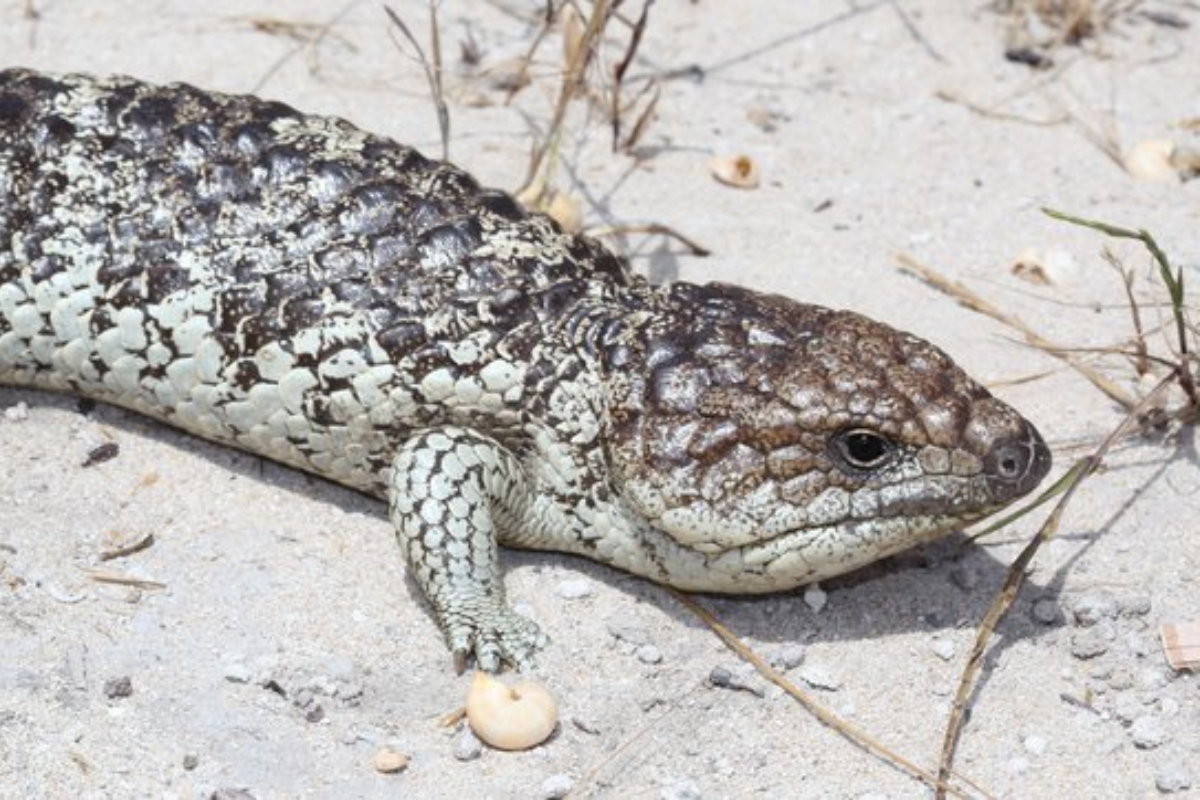
Due to their wide range of fruits and vegetables, the diet of a Shingleback Skink is mainly herbivorous. Their diet can be enriched by feeding chard leaves, kale, collard greens, squash, and carrots, which have a lot of colors, as possible sources of vitamins and other minerals, respectively. However, occasional protein sources such as crickets or mealworms should be provided, especially during the growing phases or when more energy is required. Berries and bananas are also eaten, but they should be given sparingly due to their high sugar content. They are also essential to maintain normal calcium and vitamin D3 levels to help decrease the risk of metabolic bone disease which is critical in their captivity. Fresh drinking water should be used at all times, while food and water dishes should also be cleaned often to prevent contamination.
Dietary Needs and Care Tips
Shingleback Skinks’ nutrition should predominantly concentrate on consuming leafy greens and vegetables. This range consists of kale, collard greens, squash, and carrots, rich in vitamins and other minerals. Fruits like berries and bananas are to be included but in moderation owing to the high sugar content. Occasionally, incorporate protein sources such as incests, crickets, or mealworms for servings, especially for juvenile skinks or those combining additional energy. To effectively prevent metabolic bone disease and its clinical sequel in a generalized framework, periodic calcium and vitamin D3 administration is equally essential. Water remains available throughout the day. Thus, dishes used must be cleaned regularly. Every time the food is given, it should correspond to the recommended parameters and the specific range for healthy functional activity of the skink. When you follow these dietary care and other technical guidelines, you are trying to create a healthy and better living environment for your Shingleback Skink.
Safe and Unsafe Foods for Your Pet
When taking care of Shingleback Skinks, knowing the safe and the harmful foods is essential. Mostly safe foods include various leafy greens, fruits, and meat sometimes. Some preferred greens include kale collards and mustard greens, which are more nutritious. Other vegetables, including bell pepper squash and carrots, also occur. Fruit such as berries or bananas can be offered in small quantities due to their sugar content. Protein supplementation, however, is recommended during growth stages where crickets or mealworms are some of the suitable options.
On the contrary, some foods are highly discouraged to avoid health complications. It is best to prevent lettuce from being too low in nutrition, such as icebergs and rhubarb. Some fruits bear a significant amount of citrus, and vegetables like onions and garlic are rotten for one’s health and should not be consumed. One must stick to a diet that is in harmony with a skink’s natural dietary requirements and does not include processed foods or human food. Calcium and dose-controlled vitamin D3 is recommended; D3 promotes bone health and prevents osteopenia or osteoporosis. You can prolong and optimize your pet’s well-being through the right combination of food and the elimination of however minor risks.
Feeding Schedule and Nutritional Supplements
In managing the feeding schedule for my Shingleback Skink, I ensure a structured approach to meet its dietary needs effectively. Adult skinks typically require feeding every 2-3 days, with a more frequent schedule of daily meals for juveniles due to their higher growth requirements. I primarily offer a balanced mix of leafy greens and vegetables, supplemented with fruits occasionally. Insects are provided once a week, particularly during growth phases, to boost protein intake.
For nutritional supplements, I incorporate calcium and vitamin D3 into their diet once every 2-3 feedings. This regimen helps prevent metabolic bone disease, a common concern in reptilian care. It’s critical to adhere to proper dosing: lightly dusting the supplements onto the vegetables or insects ensures adequate intake. Regularly monitoring the skink’s weight and health response is advised to adjust the feeding and supplementation routine as necessary. This systematic approach, informed by reputable dietary guidelines, supports the overall vitality and well-being of my Shingleback Skink.
How to Ensure Proper Care in Captivity for Shingleback Lizards
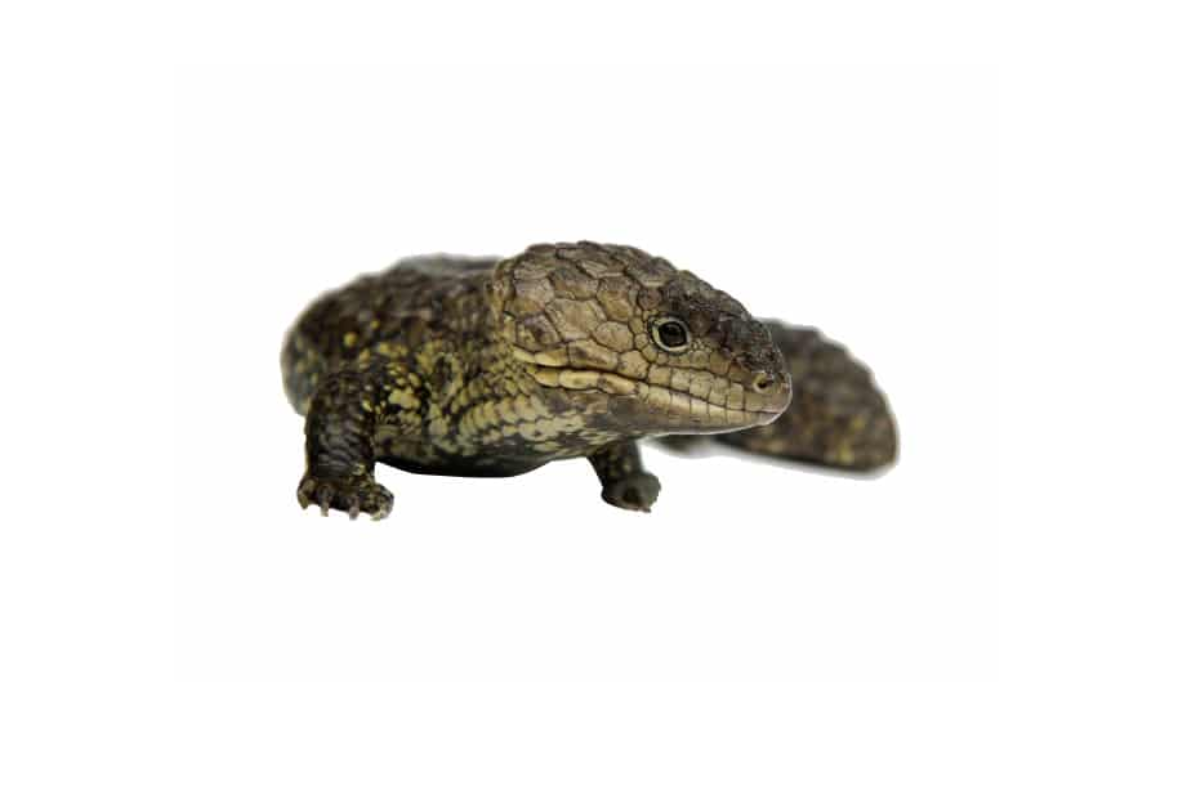
For Shingleback Lizards to be maintained in captivity, several factors must first be considered. It sets up the habitat, organizes the diet, and keeps the lizards’ health in check. First, the enclosures must provide enough space and have the suitable substrate and temperature gradients, which are essential features to aid in thermoregulation and comfort. It is also important to fit these lizards with adequate UVB lights to enable proper calcium absorption for bone-related disorders to be avoided. Emphasis must be placed on providing vegetables, fruits, and insects within the diet and a balanced diet for the lizards. Calcium and vitamin D3 supplementing must be done regularly. Besides, ensuring they are hydrated and regularly cleaning their cage reduces health risks. Designating a reptile veterinarian at the first sign of accidental injury, stress or illness, appetite changes, or decreased activity is a good practice. Providing such measures creates hope of instilling a systematic approach to managing Shingleback Lizards in captivity and improving their quality.
Daily Care Sheet Checklist
To ensure comprehensive care for Shingleback Skinks, the following daily checklist should be meticulously followed:
- Temperature and Lighting:
- Check that the basking area maintains a temperature between 95°F to 100°F (35°C to 37°C).
- Ensure that the more fantastic end of the enclosure remains around 75°F to 85°F (24°C to 29°C).
- UVB lighting should be operational, with bulbs replaced every 6-12 months. This facilitates proper vitamin D3 synthesis and calcium absorption.
- Habitat Maintenance:
- Verify the substrate is clean and dry to prevent skin and respiratory issues.
- Remove any waste or uneaten food promptly to maintain hygiene.
- Ensure there are adequate hiding spots and climbing structures to mimic their natural environment.
- Diet and Feeding:
- Prepare today’s meal with a balanced mix of leafy greens and a small portion of fruits.
- Proteins like crickets or mealworms should be given in appropriate quantities once a week.
- Dust the meal with calcium and vitamin D3 supplements as per the weekly schedule.
- Hydration:
- Provide fresh water in a shallow dish; change and clean it daily to prevent bacterial growth.
- Monitor for proper humidity levels (30%-50%) by misting the enclosure lightly if necessary, aligning with the skink’s natural habitat conditions.
- Health Monitoring:
- Observe for any behavior, appetite, or appearance changes that could indicate health issues.
- Regularly check for signs of shedding problems or irregularities in movement.
- Interaction and Enrichment:
- Spend time handling or observing the skink to ensure they are used to human interaction and to build trust.
- Adjust the environment with occasional rearrangements to provide mental stimulation and prevent boredom.
By diligently following this daily care checklist, you can foster a nurturing environment that promotes the health, happiness, and longevity of your Shingleback Skink.
Common Health Issues and Prevention
As I have seen to the well-being of my Shingleback Skinks, I could note some health compliances that are relevant issues for management that have clear preventive measures. Metabolic Bone Disease (MBD) is the most common in my practice and is often the result of insufficient calcium intake and UVB exposure. In this case, I practice appropriate calcium supplementation for prevention and solarize the UVB tubes, regularly changing them every six to twelve months to optimize Vitamin D3 metabolism. Respiratory diseases can also be a problem, usually due to improper housing conditions, particularly relative humidity levels that exceed fifty percent for long periods or a wet substrate. To prevent this, humidity levels are controlled and maintained at 30 percent to 50 percent, and substrate contamination is avoided as much as possible. Still, another problem is that internal and external parasites feed on either contaminated food or the habitat itself. Preventive measures include using clean food, cleanliness, and routine skink check-ups for any infestation effects. Periodic veterinary examinations are also essential for the timely recognition and treatment of these heath diseases, thus enhancing the quality of life of my Shingleback Skinks.
Signs of Stress and How to Address Them
Identifying any signs that might indicate that my Shingleback Skinks are stressed is essential. These lizards may show signs of stress, such as an abrupt cessation of eating or strenuous activity like fighting or being more sluggish. Additionally, these lizards will not emerge from hiding places more often than they should or would shed at abnormal intervals. In response to these concerns, I guarantee their enclosure replicates their wild setting as closely as possible, with plenty of hides and the appropriate temperatures and humidity. Regular changes in their environment through safe handling and interaction with people keep them used to people and reduce stress. Ensuring these aspects are accounted for and promptly adjusting when these parameters are violated enables me to provide my skinks with a comfortable and stress-free environment.
Where Can You Find Shingleback Skinks for Sale?
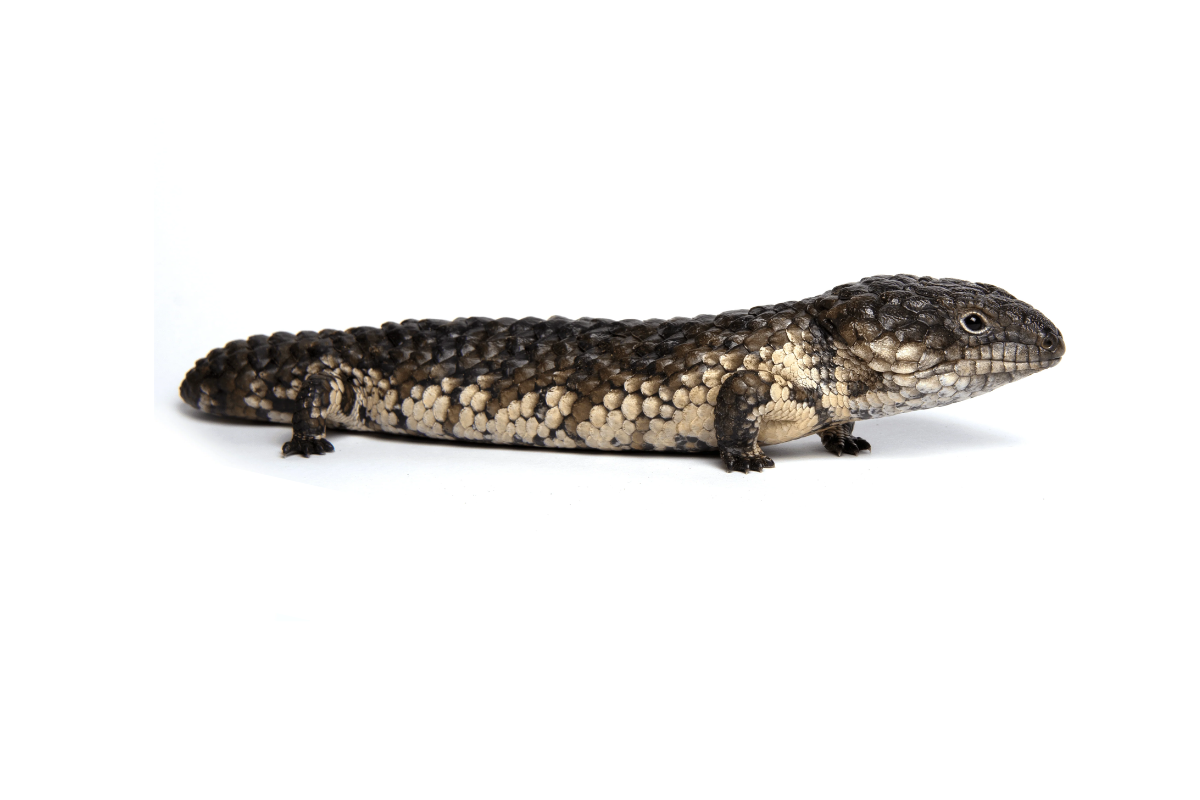
Before attempting to buy a Shingleback Skink, it is necessary to do some background checks about the animal to ascertain whether it is ethically sourced or how it was cared for. A good source of these skinks would be exotic pet breeders, who tend to have decent breeding practices and sell tame skinks bred for such habitats. It is necessary to check their qualifications and also intimacy with Shingleback Skinks. One may also do the other way around, visit area-specific or multiple reptile expos or shows, and meet some breeders while observing the skinks’ raising conditions. Additionally, reptile- a dedicated forum or similar social community- may offer valuable breeder suggestions or reviews. While buying from pet shops is possible, such Stolars should be reputable in keeping exotic reptiles. As a last point, ensure that the vendors you select have adequate materials on the skinks plus post-purchase services, which will reduce any adverse effects resulting from the changes to the Shingleback Skink.
Reputable Breeders and Vendors
- XYZ Reptiles: Based on my findings, XYZ Reptiles comes highly recommended as they prioritize ethical breeding practices and ensure their skinks are well cared for before sale. They have a strong reputation in the reptile community for healthy and well-adjusted skinks, supported by their comprehensive pre- and post-purchase guidance.
- Backwater Reptiles: This vendor is known for its wide selection of reptiles, including Shingleback Skinks. They have earned trust in the community by providing thorough care sheets and ensuring the reptiles are acclimated to different environments. However, it’s essential to confirm specific details about the care and sourcing of their skinks directly.
- MorphMarket: While primarily a marketplace connecting buyers with breeders, MorphMarket allows for detailed seller reviews and ratings. This transparency helps verify the credibility and responsiveness of breeders selling Shingleback Skinks. It’s essential to engage with breeders through this platform to assess the quality and care standards they uphold.
I can make informed decisions when purchasing a Shingleback Skink by integrating insights from these reputable sources.
Legal Considerations for Owning a Shingleback Skink
Owning a Shingleback Skink involves navigating various legal considerations, varying significantly depending on your country, state, or region. Firstly, it’s crucial to verify whether Shingleback Skinks are listed under any protected species laws or require special permits for ownership. In many areas, exotic pets like these skinks might need a local wildlife or environmental agency license. Ensure compliance with regulations such as the Convention on International Trade in Endangered Species (CITES), which aims to ensure that international trade in specimens of wild animals does not threaten their survival.
Additionally, certain regions may have restrictions based on the skink’s place of origin, especially if it is not a native species. It is advisable to consult your local Department of Fish and Wildlife or equivalent authority to acquire any necessary permits or documentation. Breeders and vendors should also provide documentation verifying the legality of their skinks and adherence to import/export laws. This process might include maintaining records of the skink’s captive-bred status, which can be necessary for legal ownership.
By thoroughly investigating and adhering to these legal requirements, you can responsibly own a Shingleback Skink while contributing to ethical wildlife conservation practices.
Adopting from Zoos and Wildlife Centers
Almost all species of Shingleback Skinks are being endangered due to habitat loss, Therefore adopting them from zoos and wildlife centers would be a great initiative not only by paying up for it but contributing towards bringing the animals back into the wild. This could easily be accomplished as skinks can be adopted from zoos or wildlife centers specialized in rehoming or surplus animals. Once the idea is considered and the resource is contacted directly, it is also necessary to ascertain if an appropriate skink has been sourced through an advertisement that requires submission of an application with an interview since it is usually the requirement throughout the industry when one wants a companion skink.
The critical factors are having a proper home for the skink & an appropriate diet plan. The most important considerations include providing enough space for the enclosure while employing various temperature, lighting, and humidity requirements to replicate an ideal environment best. Additionally, it is essential to have ongoing aftercare and a qualified veterinarian with the necessary experience with exotic reptiles before considering adoption from such trustable organizations. Providing such assets enables me to provide a suitable environment for a Shingleback Skink from a wildlife or zoo with its collection.
References
Frequently Asked Questions (FAQ)
Q: What is a shingle-back lizard, and why is it a popular pet?
A: The shingle-back lizard, also known as the sleepy lizard or pinecone lizard, is a large lizard species native to Australia’s dry areas and desert grasslands. It is part of the pet trade because it is easy to handle and makes great pets due to their tame nature and unique appearance.
Q: How do I set up a proper cage for a shingle-back lizard?
A: A cage for shingleback skinks in captivity should mimic their natural environment, ideally with sandy or gravel substrates, outdoor elements, and proper circulation. It’s essential to provide a hide and include items like bark and tin to create a comfortable habitat for your lizard.
Q: What do shingleback lizards eat?
A: Shingleback lizards are omnivorous, feeding on snails, slugs, and mice, as well as a variety of fruits and vegetables. Ensuring they have a balanced diet to meet their nutritional needs is essential.
Q: How can I distinguish between a male and female shingle-back lizard?
A: Male shingle-back lizards are typically half the size of females and have a broader head. However, confirming the sex can sometimes be difficult without professional help, as these differences can be subtle.
Q: What is the natural habitat of the shingleback lizard?
A: Shingleback lizards are native to the Australian outback. They can be found in western Australia, often in dry areas with desert grasslands and scrub, where they bask in the sun and seek shelter under rocks or bark.
Q: Do shingle-back lizards require special care during hibernation?
A: Yes, during hibernation, shingleback lizards become less active, and their need for food decreases. To encourage healthy hibernation, it’s important to monitor their habitat’s temperature and ensure they have a quiet, undisturbed environment.
Q: How often should I handle my shingle back lizard?
A: Shingle-back lizards are generally easy to handle and enjoy human interaction. Regular handling can help keep them tame, but it’s important to allow them time to rest and not handle them excessively, especially during their sleepy or hibernation periods.
Q: What unique behaviors do shingle-back lizards exhibit?
A: Shingle-back lizards are known for their unique behavior of forming monogamous pairs and staying with their partners for life. They are also quite social and can often be seen basking together at sunrise.
Q: Are there any special considerations for keeping shingle-back lizards outdoors?
A: When keeping shingle-back lizards outdoors, it’s essential to ensure they are protected from predators and have a secure enclosure. The environment should allow for natural sunlight exposure and include elements like sandy substrates and gravel to mimic their natural habitat.
